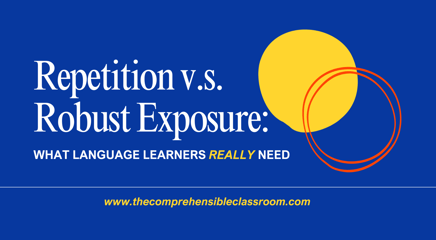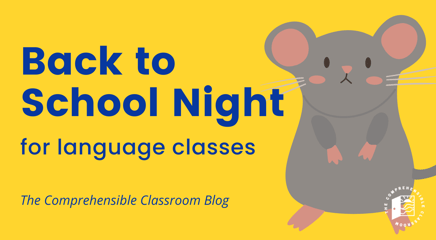As an Alaskan, PNCFL is my ‘home’ region, but with Minneapolis just a six-hour direct flight from Anchorage, I couldn’t pass up the opportunity to attend this year’s CSCTFL conference. Paired with a day spent observing Susan Block Johnson and an afternoon QAR session, it was the perfect way to spend this past week. I spent a lot of time at TPRS Publishing’s exhibitor booth (and met many of you there!), so I didn’t attend many sessions. Don’t worry, though—the five sessions that I attended will give you plenty of reading material over the next few days as I find time to gather my notes. And so, I give you The Central States Digest: Volume 1, Issue 1:
HOW TO DEEPEN READING COMPREHENSION ONE DROP AT A TIME
Presenter: Mira Canion
Activity:Character Dialogue
 Mira has five tips for preparing students to read any portion of textbook dialogue.
Mira has five tips for preparing students to read any portion of textbook dialogue.Slide © 2015 Mira Canion www.miracanion.com
Textbooks are great at including [doofy] dialogues, aren’t they? We want our students to see how the target structures would be used in real conversation, and we want them to see varied verb forms. What better way than to write out dialogues with contrived usage of as many of the words from the chapter as possible?!
Well, I’m sure that you will agree that those dialogues are neither natural nor comprehensible [effortless to understand] for most students. But can they be made comprehensible? Can they be made natural? Can they be made compelling? Mira showed us that yes, they can!
First, show only the first few lines of a dialogue to students. Since they are so packed full of new words, you want to separate them out so as to be able to prepare students for success in comprehension. Instead of 18 lines, show them 3 or 4.
 Mira works with a small section of dialogue at a time. Don't tackle the whole thing at once! Slide © 2015 Mira Canion www.miracanion.com
Mira works with a small section of dialogue at a time. Don't tackle the whole thing at once! Slide © 2015 Mira Canion www.miracanion.comMy favorite “twist” that Mira uses in her classes is to change the names of the people having the conversation. We all know that the conversation is invented, so why not have fun with it? Mira showed several examples of dialogues in which she changed the two parties in the conversation to Shrek and Fiona, Miley Cyrus and Hannah Montana, or Peeta and Katniss. Mira was so purposeful in her character selection that she chose them based on what they wear in common depictions: for example, Shrek wears a loose-fitting shirt and a vest, and Puss in Boots wears…boots! So when her textbook conversation was about whether or not to buy a vest, she re-named the character looking at the vest “Shrek”, and he asked Fiona about it instead of a friend. This simple switch transformed the “doofy” conversation into a “goofy” conversation, and it became interesting because we all know and like Shrek. The Hannah Montana/Miley Cyrus conversation switcheroo was an obvious choice for a conversation about buying a skirt, which then turned into whether or not it was too short to purchase. This made the skirt conversation compelling because everyone has an opinion on Miley Cyrus.
Once you insert familiar characters, you are able to do all kinds of extension activities. Students’ background knowledge on the characters allows them to meaningfully do things like modifying the conversation, predicting what would happen next in the conversation, and adding to the conversation. This is fun to do when you know the people that are talking. If you don’t know the people that are talking, it’s not fun to play with their words because…well…who knows what they would say, and who cares?
Beyond manipulating the dialogue itself, Mira provided many ideas for using the dialogues as the subject of critical thinking. Some of the ways that she has done this in class is to talk through the process of sifting out details in order to find the main idea. As you re-read the dialogue with the class, ask questions in the target language like, “Is this necessary information?”, “Can we delete this and not change the conversation?” By working through it as a class, you are providing additional, comprehensible input, and you are helping students to become strategic readers as they practice the skill of metacognition. To meet some of the less-natural-to-include Common Core Standards (click here for posts on CCSS Alignment), Mira suggested asking questions like, “What effect does the author achieve by choosing Hannah as Miley’s friend?”, “What background information does the reader need to see the humor in choosing Hannah as Miley’s friend?”, etc. I love this!
We’re not done yet!!
Mira also provided many ideas for output. She has students create character webs based on the dialogue, write out comics based on the plot (extending and adding in unique details), and, my favorite, a “Blind Image Retell”. I love blind retells, which I learned about from Betsy Paskvan, and Mira’s twist is excellent. As you can see in the image, Mira begins this activity by asking students to fold a paper in half lengthwise. Then, the students re-write the dialogue on the left-hand side of the paper. On the right-hand side of the paper, they illustrate the dialogue. Then, they fold it in half again. Students then re-tell the conversation to a partner or to a friend or parent for homework as they look at the illustrations. The person to whom they are re-telling the story looks at the written dialogue and checks for accuracy. If it is a student listening to the re-tell, that student is receiving comprehensible input as they read through the text and listen critically for mistakes and deletions. Then, the roles can switch.
Once you’ve done a few of these activities with one chunk of the dialogue, move on to the next chunk and do some new ones. Students will acquire the vocabulary contained within them more deeply than ever before! I was so inspired by the session that it *almost* made me want to teach out of a textbook ;-)
If you are tied to a textbook and looking for ways to incorporate comprehensible input, please consider bringing Mira to your school for a workshop. She is particularly familiar with Realidades because she uses it (she actually plays a game where you give her a vocabulary word and she tells you which chapter and section in Realidades it is introduced…she knows it that well), but she would be able to work with you on any text. Click here to visit the “contact” page on Mira’s website!
I’ll be blogging about more other ideas from Mira’s sessions (and others), so stay tuned!





